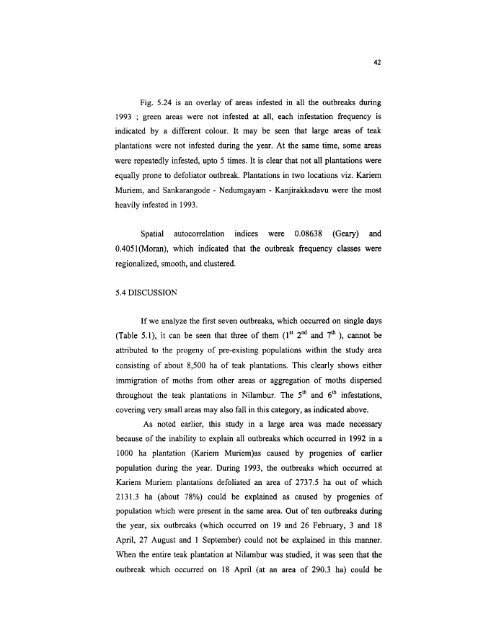Spatial dynamics of teak defoliator (Hyblaea puera Cramer) - Cochin ...
Spatial dynamics of teak defoliator (Hyblaea puera Cramer) - Cochin ...
Spatial dynamics of teak defoliator (Hyblaea puera Cramer) - Cochin ...
Create successful ePaper yourself
Turn your PDF publications into a flip-book with our unique Google optimized e-Paper software.
Fig. 5.24 is an overlay <strong>of</strong> areas infested in all the outbreaks during<br />
1993 ; green areas were not infested at all, each infestation frequency is<br />
indicated by a different colour. It may be seen that large areas <strong>of</strong> <strong>teak</strong><br />
plantations were not infested during the year. At the same time, some areas<br />
were repeatedly infested, upto 5 times. It is clear that not all plantations were<br />
equally prone to <strong>defoliator</strong> outbreak. Plantations in two locations viz. Kariem<br />
Muriem, and Sankarangode - Nedumgayam - Kanjirakkadavu were the most<br />
heavily infested in 1993.<br />
<strong>Spatial</strong> autocorrelation indices were 0.08638 (Geary) and<br />
0.4051(Moran), which indicated that the outbreak frequency classes were<br />
regionalized, smooth, and clustered.<br />
5.4 DISCUSSION<br />
If we analyze the first seven outbreaks, which occurred on single days<br />
(Table 5.1), it can be seen that three <strong>of</strong> them (1sI 2 nd and 7 th ), cannot be<br />
attributed to the progeny <strong>of</strong> pre-existing populations within the study area<br />
consisting <strong>of</strong> about 8,500 ha <strong>of</strong> <strong>teak</strong> plantations. This clearly shows either<br />
immigration <strong>of</strong> moths from other areas or aggregation <strong>of</strong> moths dispersed<br />
throughout the <strong>teak</strong> plantations in Nilambur. The Sth and 6 th infestations,<br />
covering very small areas may also fall in this category, as indicated above.<br />
As noted earlier, this study in a large area was made necessary<br />
because <strong>of</strong> the inability to explain all outbreaks which occurred in 1992 in a<br />
1000 ha plantation (Kariem Muriem)as caused by progenies <strong>of</strong> earlier<br />
population during the year. During 1993, the outbreaks which occurred at<br />
Kariem Muriem plantations defoliated an area <strong>of</strong> 2737.S ha out <strong>of</strong> which<br />
2131.3 ha (about 78%) could be explained as caused by progenies <strong>of</strong><br />
population which were present in the same area. Out <strong>of</strong> ten outbreaks during<br />
the year, six outbreaks (which occurred on 19 and 26 February, 3 and 18<br />
April, 27 August and 1 September) could not be explained in this manner.<br />
When the entire <strong>teak</strong> plantation at Nilambur was studied, it was seen that the<br />
outbreak which occurred on 18 April (at an area <strong>of</strong> 290.3 ha) could be<br />
42
















